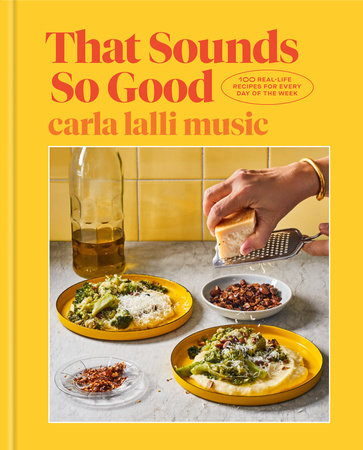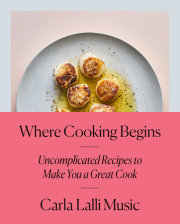Chapter 1
ABC: Always Be CookingHere’s how to celebrate and embrace the act of cooking and eating in your everyday life, no matter what
Cook in this moment, whichever moment you’re in
This book is organized by situation and occasion, rather than by ingredient or recipe type. I’ve divided a typical week into two buckets: Monday through Thursday, and Friday and the Weekend. My life looks a lot different on a Tuesday evening—after finishing work and catching up with a family that’s been scattered all over the place—than it does on a Saturday afternoon, when I might have enough free time to let one of my cats take a nap on my chest. But no matter what day of the week it is, a girl’s gotta eat! Within the weekday and weekend sections of this book, the individual chapters are devoted to the sorts of everyday scenarios you and I might find ourselves in—an effort to capture the types of meals that will fit into your actual life.
In the weekday chapters, you’ll find stovetop suppers and dinner salads, and a chapter on the healthyish recipes that I crave after a weekend of eating and drinking and sleeping in. With many of us juggling work, school, housekeeping, caretaking, and commuting, these weekday dishes make the most of short active times. Half an hour of effort can add up to a complete meal if you know how to prioritize your prep and cook times.
By comparison, the weekend section is mostly devoted to recipes with longer cook times and some with larger serving sizes: soups, stews, braises, roasts, and things to grill. That said, even when you do have the downtime to afford to park something on the back of the stove or in a low oven for a couple-few hours, I don’t want you to spend more than about half an hour of active cooking time to get that meal going or finish it up. (Grilling is a bit of an exception, since it’s one of the few times that cooking overlaps with hanging out. But there are many grilling recipes here that can be made before your friends arrive, if that’s how you like to party.) I love having people over, but my overambitious-entertainer phase—when I could be found piping out gougères at 2 a.m. the night before a holiday party—is done. My kind of weekend food isn’t annoying, complicated, or technically challenging. I treasure my time off, and I don’t want to spend every minute of it standing in one spot, staring at a cutting board. There are also plenty of weekend recipes here for the kinds of weekends where you are really feeling lazy.
By all means, make whatever you want on any day you like! I don’t bake during the week, which is why the desserts chapter falls in the weekend section of the book, but if you want a cobbler on a Tuesday, I’m not going to stop you. Some of the big salads found in the weekday section make excellent, uncomplicated additions to a mellow lunch on the weekend, and can also be treated as quick-to-prepare vegetable sides to go with a big braise. There’s a set of suggested menus on page 281 that I put together to help you mix and match meals from the recipes throughout the book.
Monday through Thursday:Your time is precious.
How to get big payoff from short active timesThe recipe instructions in this book are written chronologically, which means that I will rarely call for things to be already prepped in the ingredient list (i.e., “1 cup chopped onions”). Instead, you’ll see whole ingredients listed, and I’ll talk you through the most efficient moment in which to prep them in the recipe method itself. I am all about balancing inactive and active times, and using inactive time to your benefit when cooking. Despite what you might have heard chefs say about their restaurant mise en place, it doesn’t always make sense to prep every single thing before you start cooking. I’ve set up my recipes so you start the longest-cooking item first, and while that is in process, you’ll use the downtime (inactive time) to prep the things that go with it. If I’m going to have rice with a meal, I put that on at the top, then use the 18 minutes it takes the rice to cook to make whatever else will be on the table (see the recipe for Gingery Ground Beef with Lime and Herbs on page 60 for an example of how this works). Rice can sit after it’s done, so if it takes me a little longer to finish the other components of the meal, dinner won’t suffer. If something needs to marinate, like the tomatoes on page 216, or soak, like the crunchy vegetables in the salad on page 108, I’ll prompt you to get that going, then turn to the other ingredients.
There are absolutely occasions when you should chop and measure everything before anything hits a skillet, such as when you’re making a stir-fry, deep-frying something, or making caramel sauce. There’s no downtime built into the steps of those types of recipes, and the dish can be ruined if you try to pause in the middle. When that’s the case, I make it clear that you need everything ready before you switch on a burner. These choices and approaches are all about time management and informed prioritizing—and will reduce the overall time you spend making your meals.
When making a quick dinner, the inactive and active times overlap neatly; from beginning to end, you can use every minute to your advantage. Take the pork chops on page 41: They are seasoned in the first step and left to sit for a few minutes while you wash the radicchio and slice the onion that go with the pork. After cooking, the chops rest for 10 minutes—a necessary part of their journey!—while you sauté the vegetables in the pork drippings left in the skillet. Once the veggies are done, the pork will be ready to slice and you can eat. Filling inactive time with active steps that keep you moving toward the finish line means you’ve used time to your advantage.
Friday and the Weekend:Your time stretches out.
How to layer prep times over stretches of inactive timeIf weeknight cooking is all about stacking active and inactive times, weekend cooking affords you the chance to front-load a meal with a finite amount of busywork, then lean into truly hands-off methods. In the weekend section, you’ll find plenty of cold-weather slow roasts and braises. Ideally, the proteins in these recipes are seasoned (days) ahead of time, then left to gently cook, unattended, while you do whatever you want in some other room. There are also warm-weather vegetable dishes that benefit from long marinating times; set them up when you feel like it and sit down to eat hours later. There are bean dishes accompanied by quick-blitzed pestos to spoon over (see page 138), and an Italian-style steak salad that is best at room temperature (that recipe is on page 122). There are soups that can be reheated gently when you decide it’s dinnertime. My grilling recipes are organized around the idea that you can prep your ingredients while the fire heats up, then grill in waves, snacking on things as they are ready, rather than trying to have an entire meal’s worth of dishes miraculously char to completion at the same time. The idea that links the weekend recipes is that you can stretch the inactive time to suit the rhythm of your day, bracketing your active involvement so that your free time stays free. Whenever you find yourself with a day devoid of work, school, or other structured commitments, you can take advantage of this approach, and these recipes are incredibly adaptable for anyone who works from home. If you have the flexibility to start a dish in the early part of the day and come back to check on it a few hours later, hands-off recipes are your support crew.
When I hear the phrase “project cooking,” it makes me think that a lot will be required of me over a long period of time. This is true of cassoulet, Persian rice, shoyu ramen, and orange marmalade. It’s fun to cook like that—sometimes. Like when a blizzard is on the way, a major birthday milestone needs celebrating, or you’re coming up with distractions so you don’t have to finish writing your book. That’s not what my style of weekend cooking looks like, though (I never procrastinate). In my home, the weekend is for dishes that taste and feel like a lot went into them, only because they rely on hands-off methods and passive time devoted to flavor development (dry brines, marinated veggies, and slow roasts, for example). They are generously portioned for sharing with friends or to ensure a couple of days’ worth of leftovers—perfect for meal preppers and lunch packers.
Copyright © 2021 by Carla Lalli Music. All rights reserved. No part of this excerpt may be reproduced or reprinted without permission in writing from the publisher.







